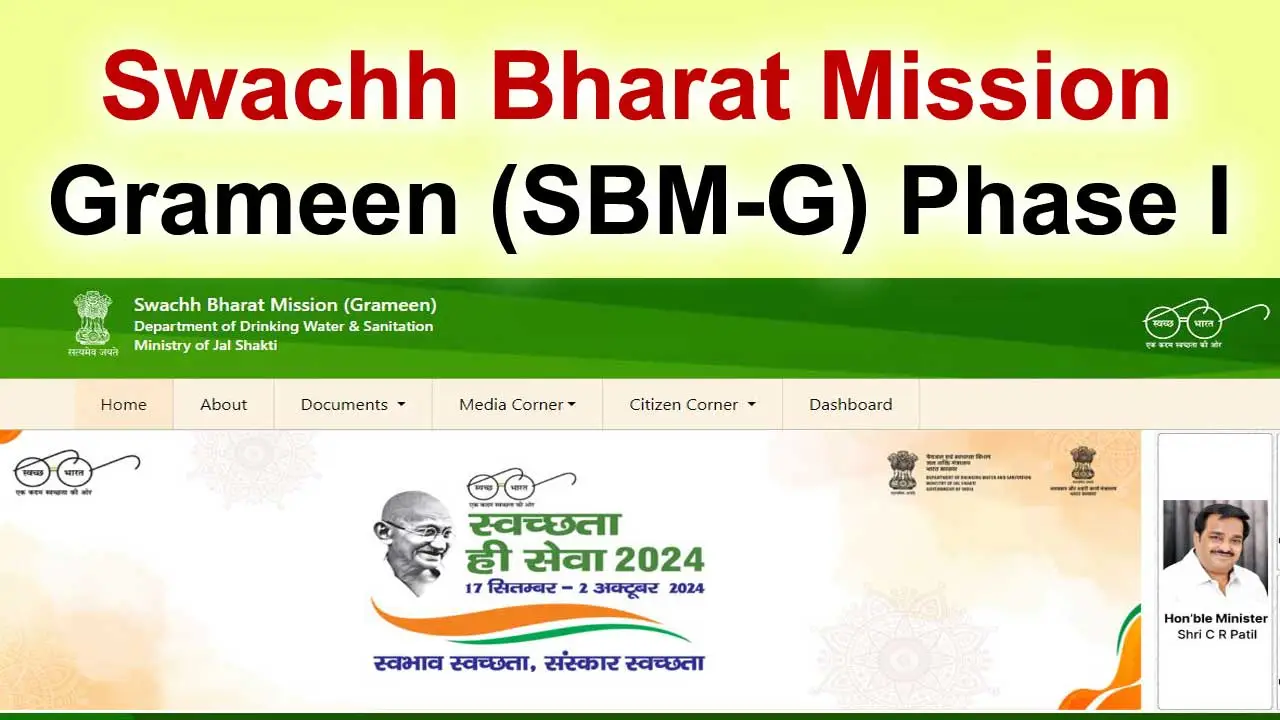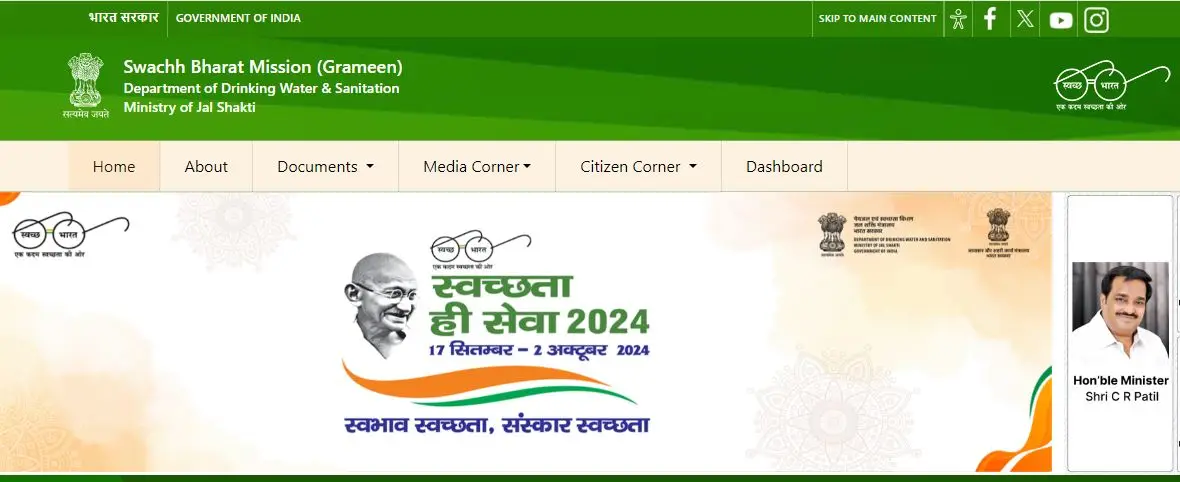Swachh Bharat Mission Grameen (SBM-G) Phase I: PM Swachh Bharat Mission Scheme Grameen Apply
The Swachh Bharat Mission (SBM), one of India’s most ambitious cleanliness initiatives, was launched by the Prime Minister of India on 2nd October 2014, with the goal of achieving universal sanitation coverage. The program is aimed at eliminating open defecation in rural India by constructing individual household toilets and community sanitary complexes. Over time, SBM became a transformative initiative, fostering a sanitation movement across the nation and promoting safe sanitation practices.

This blog will explore Swachh Bharat Mission Grameen (SBM-G) Phase I in detail, the steps for online application, and how individuals can benefit from it.
Table of Contents
☰ Menu- What is Swachh Bharat Mission Grameen (SBM-G) Phase I?
- Key points of the PM Swachh Bharat Mission (Grameen) Scheme
- Objectives of Swachh Bharat Mission – Grameen (Phase I)
- Key Activities under SBM-G Phase I
- Order of Preference for Scheme Implementation
- How to Apply for the Swachh Bharat Mission Grameen Phase I Scheme
- How to Apply for the Swachh Bharat Mission Grameen Phase I Scheme
- Financial Assistance Under SBM-G Phase I
- Achievements of Swachh Bharat Mission – Grameen Phase I
- Summary
What is Swachh Bharat Mission Grameen (SBM-G) Phase I?
Swachh Bharat Mission – Grameen (SBM-G) Phase I was aimed at achieving the goal of making India open defecation free (ODF). The mission’s main focus was on ensuring that every rural household had access to safe and sustainable sanitation facilities. It was launched as a part of the larger Swachh Bharat Mission with an emphasis on rural areas. The goal of SBM-G was successfully achieved on 2nd October 2019, the 150th birth anniversary of Mahatma Gandhi.
By October 2019, more than 100 million toilets were constructed in rural India, helping villages, Gram Panchayats, districts, states, and Union Territories to declare themselves as “open defecation free” (ODF).
Key points of the PM Swachh Bharat Mission (Grameen) Scheme
| Key Points | Details |
|---|---|
| Launch Date | 2nd October 2014 |
| Objective | Achieve universal sanitation coverage and make rural India open defecation free (ODF) |
| Implemented By | Ministry of Drinking Water and Sanitation (now Ministry of Jal Shakti) |
| Phase I Completion Date | 2nd October 2019 (150th birth anniversary of Mahatma Gandhi) |
| Financial Support for Toilets | Rs. 12,000 per household for APL and BPL rural households |
| Incentive Delivery | Payment in cash, construction materials, or credit vouchers for materials |
| Key Activities | - Construction of Individual Household Latrines (IHHL) - Construction of Community Sanitary Complexes (CSCs) |
| Solid Liquid Waste Management (SLWM) | Focus on the safe management of solid and liquid waste in villages |
| Information, Education, and Communication (IEC) | Awareness campaigns to promote sanitation and behavioral change |
| Human Resource Development (HRD) | Training local governance structures and leaders for sustained sanitation practices |
| Priority Beneficiaries | - BPL households - APL households - SC/ST - Persons with disabilities - Widow/old-age pensioners |
| Success | Over 100 million toilets constructed in rural India, all villages declared ODF by 2nd October 2019 |
| Next Phase (ODF Plus) | Focus on sustaining ODF behaviors and managing solid and liquid waste |
| Online Application Platforms | - Swachh Bharat Mission Official Website - UMANG app |
Objectives of Swachh Bharat Mission – Grameen (Phase I)
Elimination of Open Defecation: The core objective of SBM-G Phase I was to ensure that rural India becomes open defecation free (ODF) by constructing toilets for individual households and communities.
Behavioural Change: Through extensive communication campaigns, SBM-G focused on changing the behavior of the rural population regarding sanitation. The Information, Education, and Communication (IEC) component played a crucial role in making people aware of the importance of using toilets and the health hazards of open defecation.
Capacity Building: Another important objective was to build the capacity of local governance structures like Gram Panchayats and community leaders to sustain the outcomes of the sanitation efforts and keep the villages open defecation free.
Community Participation: SBM-G was designed to be a community-led program with strong participation from local residents. People were encouraged to take ownership of their sanitation facilities and ensure proper maintenance.
Key Activities under SBM-G Phase I
SBM-G focused on various activities to achieve its goals. These included:
Construction of Individual Household Latrines (IHHL): Under SBM-G, financial assistance of Rs. 12,000 was provided to rural households to construct toilets. This amount was sufficient to cover the basic cost of constructing toilets along with storage facilities for handwashing and cleaning.
Construction of Community Sanitary Complexes (CSCs): In areas where individual households couldn’t construct toilets due to space constraints or other limitations, community sanitary complexes (CSCs) were built. These were constructed in common areas and were available for community use.
Solid Liquid Waste Management (SLWM): SBM-G also focused on the management of solid and liquid waste in rural areas. It encouraged setting up waste disposal systems that would contribute to a cleaner environment.
Information, Education, and Communication (IEC): A massive communication campaign was carried out under SBM-G to inform, educate, and communicate the importance of sanitation and hygiene to rural households. The IEC strategy involved local mediums such as street plays, posters, and radio broadcasts to ensure that the message reached even the most remote areas.
Human Resource Development (HRD): Local human resources were trained to carry out the activities of the mission, ensuring proper planning and implementation.
Order of Preference for Scheme Implementation
The following order of preference was given while extending the benefits of the SBM-G scheme:
- Below Poverty Line (BPL) households
- Above Poverty Line (APL) households
- Scheduled Castes (SC) and Scheduled Tribes (ST)
- Persons with disabilities
- Widows/old-age pensioners
- Landless laborers with homesteads
- Small farmers
- Marginal farmers
This order ensured that the most vulnerable and marginalized sections of society were given priority in receiving sanitation benefits.
How to Apply for the Swachh Bharat Mission Grameen Phase I Scheme
The process to apply for SBM-G Phase I benefits is simple, and individuals can register and apply online. Here’s a step-by-step guide to the application process:
Register Online: To apply for the SBM-G scheme, applicants need to visit the official Swachh Bharat Mission website or use the UMANG mobile app for registration. The UMANG app offers a streamlined process to access all government services in one place.
Website: Swachh Bharat Mission Official Site

Complete the Application Process: After registration, you will need to complete the application process by filling in your personal details, address, and other required information.
Submit the Form: After filling in all the required information, review your details carefully before submitting the form online. Ensure that the information provided is accurate to avoid any delays in processing.
Follow Up: Once the form is submitted, you can follow up on the status of your application through the website or the UMANG app. You may also be contacted by local authorities to verify the information provided.
Financial Assistance Under SBM-G Phase I
Eligible households, both APL and BPL, received financial assistance of Rs. 12,000 for the construction of toilets. This amount covered the cost of the toilet as well as storage for handwashing and cleaning. The incentives could be provided either in cash or in the form of construction materials, depending on the discretion of local authorities.
Achievements of Swachh Bharat Mission – Grameen Phase I
By the end of Phase I, SBM-G had achieved remarkable success:
More than 100 million toilets constructed: The mission enabled the construction of individual household latrines (IHHLs) in rural areas, significantly reducing open defecation.
Behavioral Change: Extensive awareness campaigns helped change the mindset of people regarding the use of toilets and sanitation practices.
Open Defecation Free (ODF) Declaration: All villages, Gram Panchayats, districts, and states declared themselves open defecation free by 2nd October 2019.
Summary
Swachh Bharat Mission – Grameen Phase I was a historic step towards achieving universal sanitation coverage in rural India. It laid the foundation for a cleaner and healthier India by eradicating open defecation and promoting safe sanitation practices. The achievements of this phase have set the stage for the next phase, ODF Plus, which will focus on sustaining the gains of Phase I and addressing the issues of solid and liquid waste management.
For those who haven’t yet availed of the scheme, it’s easy to apply online and ensure access to safe sanitation for your household. SBM-G remains a community-driven initiative that continues to transform rural India.
 Telegram
Telegram
Comments Shared by People